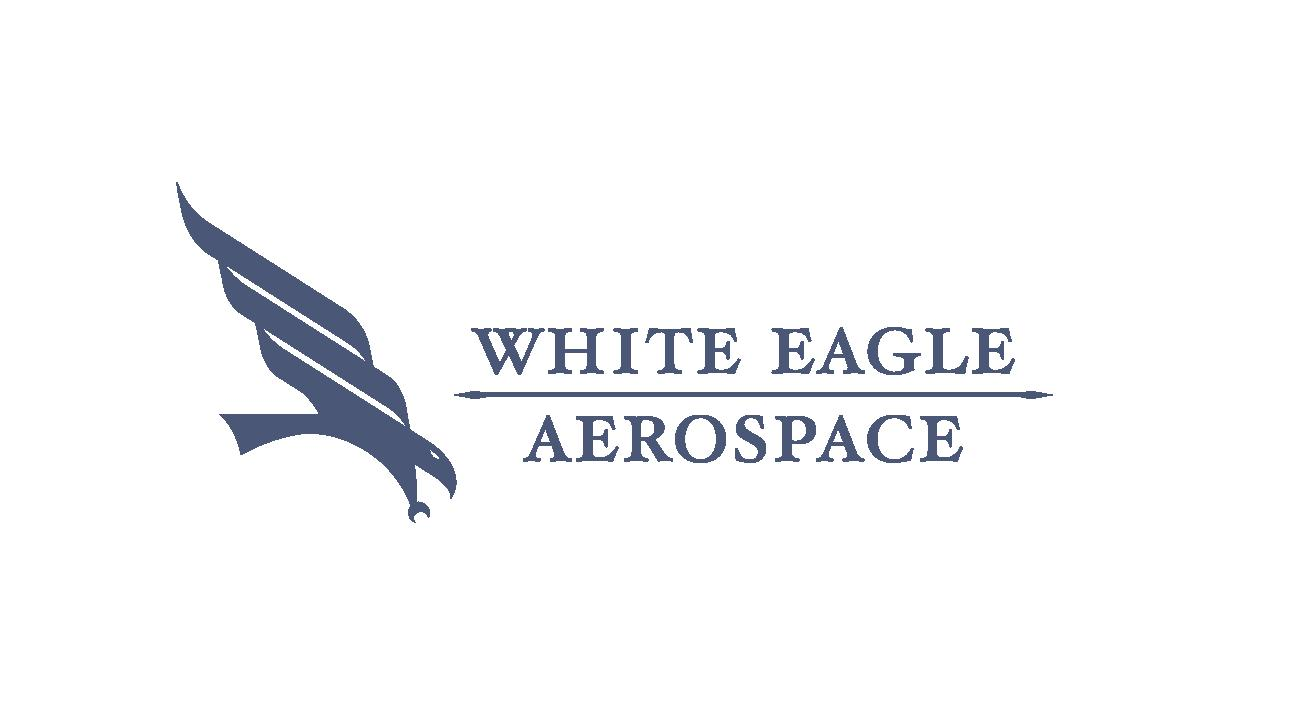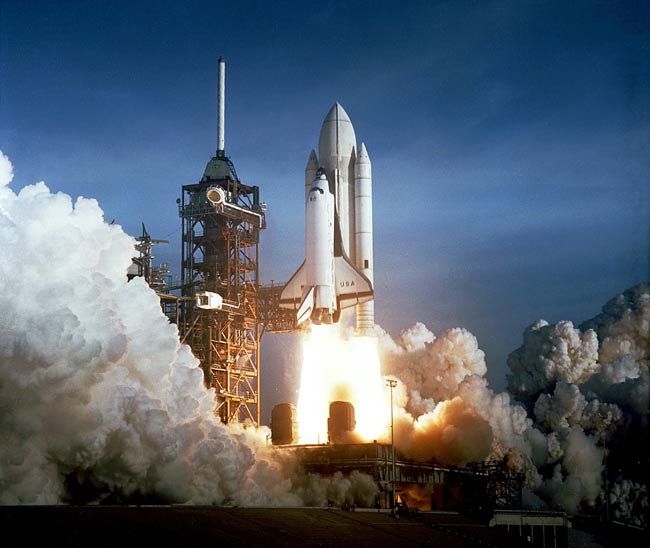
Twenty-nine years ago today, the United States successfully launched the Space Shuttle Columbia into orbit about the Earth. It was the maiden flight of the Nation’s Space Transportation System (STS).
The Space Shuttle was unlike any manned space vehicle ever flown. A giant aircraft known as the Orbiter was side-mounted on a huge liquid-propellant stage called the External Tank (ET). Flanking opposing sides of the ET was a pair of Solid Rocket Boosters (SRB). The Orbiter, SRB’s and ET measured 122 feet, 149 feet and 154 feet in length, respectively.
The Space Shuttle system was conceived with an emphasis on reusability. Each Orbiter (Columbia, Challenger, Atlantis, Discovery and Endeavor) was designed to fly 100 missions. Each SRB was intended for multiple mission use as well. The only single-use element was the ET since it was more cost effective to use a new one for each flight than to recover and refurbish a reusable version.
NASA called STS-1 the boldest test flight in history. Indeed, the STS-1 mission marked the first time that astronauts would fly a space vehicle on its inaugural flight! STS-1 was also the first time that a manned booster system incorporated solid rocket propulsion. Unlike liquid propellant rocket systems, once ignited, the Shuttle’s solid rockets burned until fuel exhaustion.
And then there was the Orbiter element which had its own new and flight-unproven propulsion systems. Namely, the Space Shuttle Main Engines (SSME) and Orbital Maneuvering System (OMS). Each of the three (3) SSME’s generated 375,000 pounds of thrust at sea level. Thrust would increase to 475,000 pounds in vacuum. Each OMS rocket engine produced 6,000 pounds of thrust in vacuum.
The Orbiter was also configured with a reusable thermal protection system (TPS) which consisted of silica tiles and reinforced carbon-carbon material. The TPS for all previous manned space vehicles utilized single-use ablators. Would the new TPS work? How robust would it be in flight? What post-flight care would be needed? Answers would come only through flight.
To add to the “excitement” of first flight, the Orbiter was a winged vehicle and would therefore perform a hypersonic lifting entry. The vehicle energy state would have to be managed perfectly over the 5,000 mile reentry flight path from entry interface to runway touchdown. Since the Orbiter flew an unpowered entry, it would land dead-stick. There would only be one chance to land.
On Sunday,12 April 1981, the Space Shuttle Columbia lifted-off from Pad 39A at Cape Canaveral, Florida. Official launch time was 12:00:03 UTC. The flight crew consisted of Commander John W. Young and Pilot Robert L. Crippen. Their Columbia launch stack tipped the scales at 4.5 million pounds and thundered away from the pad on over 7 million pounds of thrust.
Columbia went through maximum dynamic pressure (606 psf) at Mach 1.06 and 26.5 KFT. SRB separation occurred 120 seconds into flight at Mach 3.88 and 174,000 feet; 10,000 feet higher than predicted. This lofting of the ascent trajectory was later attributed to unmodeled plume-induced aerodynamic effects in the Orbiter and ET base region.
Following separation, Columbia rode the ET to burnout at Mach 21 and 389.7 KFT. Following ET separation, Columbia’s OMS engines were fired minutes later to achieve a velocity of 17,500 mph and a 166-nautical mile orbit.
Young and Crippen would orbit the Earth 37 times before coming home on Tuesday, 14 April 1981. In doing so, they successfully flew the first hypersonic lifting reentry from orbit. Though unaware of it at the time, the crew came very close to catastrophe as the Orbiter’s body flap had to be deflected 8 degrees more than predicted to maintain hypersonic pitch control.
The reason for this “hypersonic anomaly” was that ground test and aero modeling had failed to capture the effects of high temperature gas dynamics on Orbiter pitch aerodynamics. Specifically, the vehicle was more stable in hypersonic flight than had been predicted. This necessitated greater nose-down body flap deflections to trim the vehicle in pitch. It was a close-call. But Columbia and its crew lived to fly another day.
Columbia touched-down at 220 mph on Runway 23 at Edwards Air Force Base, California at 18:20:57 UTC. Young and Crippen were euphoric with the against-the-odds success of the Space Shuttle’s first mission.
NASA too reveled in the Shuttle’s accomplishment. And so did America. This was the country’s first manned space mission since 1975. The longest period of manned spaceflight inactivity ever in the Nation’s history.
Fittingly, a well-known national news magazine celebrated Columbia’s success with a headline which read: “America is Back!”
And while it flies no more, we remember that first Orbiter, its first flight and its many subsequent accomplishments. To which we say: Hail Columbia!
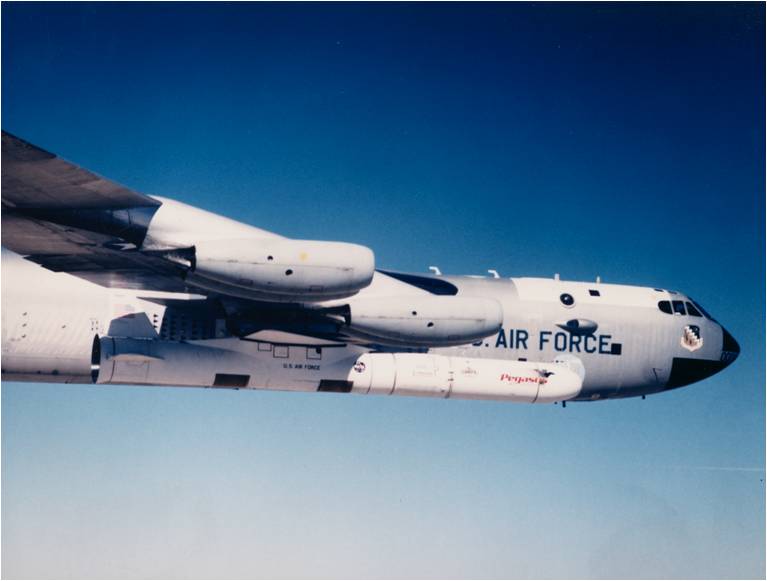
Twenty-years ago today, the Orbital Sciences Corporation (OSC) orbited a PegSat satellite using the then-new Pegasus 3-stage launch vehicle. This historic event marked the first successful implementation of the air-launched satellite launcher concept.
The concept of air-launch dates back to the 1940’s and the early days of United States X-plane flight research. A multi-engine aircraft known as the mothership was employed to transport a smaller test aircraft to altitude. The test aircraft was subsequently dropped from the mothership and went on to conduct the flight research mission.
A clear benefit of air-launch was that all of the fuel and propulsion required to get to the drop point was provided by the mothership. Thus, the test aircraft was allowed to use all of its own fuel for the flight research mission proper. In that sense, the mothership-test aircraft combination functioned as a two-stage launch vehicle.
The value and efficacy of the air-launch concept was demonstrated on numerous X-plane programs. Flight research aircraft such as the Bell XS-1, Bell X-1A, Bell X-1E, Bell X-2, Douglas D-558-II, and North American X-15 were all air-launched. More recently, the X-43A and X-51A scramjet-powered flight research vehicles also employed the air-launch concept.
An added benefit of the air-launch technique is that the launch site is highly portable! This provides enhanced mission flexibility compared to fixed position launch sites. The associated operating costs are much lower for the air-launched concept as well.
Orbital Science’s original Pegasus launch vehicle configuration was designed to fit within the dimensional envelope of the X-15. The standard Pegasus configuration measured 50 feet in length and had a wingspan of 22 feet. The same dimensions as the baseline X-15 rocket airplane. Pegasus body diameter and launch weight were 50 inches and 41,000 pounds, respectively.
A key design feature of the Pegasus 3-stage launch vehicle configuration was the vehicle’s trapezodal-planform wing which provided the aerodynamic lift required to shape the endoatmospheric portion of the ascent flight path. This made Pegasus even more X-15-like.
The real difference between Pegasus and the X-15 was propulsion. The X-15 performed a sub-orbital mission using an XLR-99 liquid rocket engine rated at 57,000 pounds of sea level thrust. Pegasus used a combination of three (3) Hercules solid rocket motors to perform an orbital mission. The 1st, 2nd and 3rd stage rocket motors were rated at 109,000, 26,600 and 7,800 pounds of vacuum thrust, respectively.
On Thursday, 05 April 1990, the first Pegasus launch took place over the Pacific Ocean within an area known as the Point Arguello Western Air Drop Zone (WADZ) . Pegasus 001 fell away from its NASA B-52B (S/N 52-0008) mothership at 19:10 UTC as the pair flew at Mach 0.8 and 43,000 feet. Pegasus first stage ignition took place 5 seconds after drop.
Following first stage ignition, the Pegasus executed a pull-up to begin the trip upstairs. The second and third stage rocket motors fired on time. The stage separation and payload fairing jettison events worked as planned. Roughly 10 minutes after drop, the 392-pound PegSat payload arrived in a 315 mile x 249 mile elliptical orbit.
Since that triumphant day in April 1990, both the Pegasus launch vehicle configuration and mission have grown and matured. Of a total of 40 official Pegasus missions to date, 37 have been flown successfully.
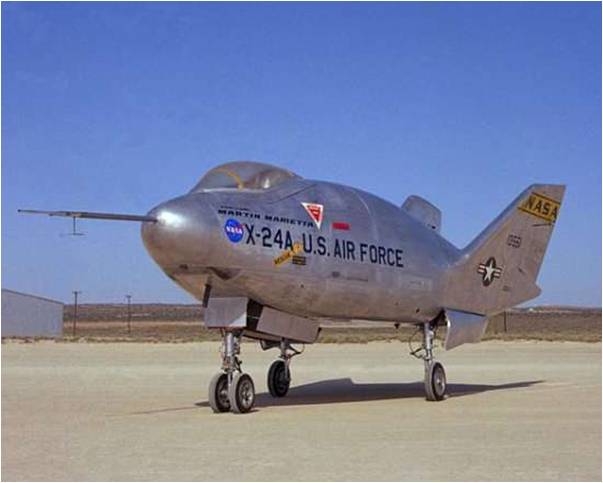
Thirty-nine years ago today, the USAF/NASA X-24A lifting body was flown to a speed of 1,036 mph (Mach 1.6) by NASA Research Pilot John Manke. It was the fastest flight of the rocket-powered lifting body.
A lifting body is an unconventional aircraft in that the vehicle generates lift without the benefit of a wing. Rather, the aircraft produces lift by the manner in which its fuselage is shaped.
In the early days of manned spaceflight, there were two schools of thought regarding the preferred mode of entry from orbital flight. One camp favored ballistic entry where the predominant flight force was aerodynamic drag. This was in contradistinction to lifting entry where both aerodynamic lift and drag forces were generated.
Ballistic entry is the more simple approach, but affords little control of the endoatmospheric flight path. This stems from the fact that the landing point for a ballistic entry is largely dictated by the entry vehicle’s velocity and flight path angle at entry interface.
While operationally more complicated, lifting entry provides a positive means for controlling the entry vehicle’s flight path and thus its landing point. At hypersonic speeds, even a small amount of lift markedly enhances entry vehicle downrange and crossrange capability.
Part of the complication of designing a lifting entry vehicle stems from the need to deal with high levels of heating during entry flight. The vehicle’s shape not only dictates its aerodynamic capabilities, but its aerodynamic heating characteristics as well. Thus, issues of flight path control and airframe survivability are interrelated.
The heyday of lifting body flight research spans the period from 1963 to 1975. For the record, the lifting bodies flown in that era include the following vehicles: M2-F1, M2-F2, M2-F3, HL-10, X-24A and X-24B. Each of these aircraft were piloted. All lifting body flight research was conducted at Edwards Air Force Base, California.
The X-24A was developed by the Martin Company under contract to the United States Air Force. A single X-24A was produced. It measured 24.5 feet in length and had a gross weight of 11,450 pounds. Airframe empty weight was 6,300 pounds.
Though unconventional in shape, the X-24A incorporated full 3-axis flight controls. The aircraft was powered by the venerable XLR-11 rocket motor. This four-chambered propulsion system was rated at 8,500 pounds of sea level thrust. Maximum burn time was on the order of 140 seconds. All landings were conducted deadstick.
The X-24A displayed generally good handling characteristics, but had to be flown precisely. Angle-of-attack had to be maintained between about 4 and 12 degrees. Flight at lower and higher angles-of-attack encountered undesirable aerodynamic control and cross-coupling characteristics.
On Monday, 29 March 1971, X-24A (S/N 66-13551) fell away from the B-52B mothership in an effort to fly a maximum speed mission. NASA research pilot John Manke was at the controls. Manke accelerated the aircraft in a climb and reached a record speed of 1,036 mph (Mach 1.6). Interestingly, it was John Manke who had previously flown the X-24A to its highest altitude of 71,407 feet on 27 October 1970.
The X-24A, like all of the lifting bodies, contributed significantly to the decision to land the Space Shuttle Orbiter deadstick. The lifting bodies, as well as X-aircraft such as the X-1, X-2, and X-15, proved conclusively that an aircraft could reliably (1) manage its energy state and (2) precisely control touchdown point in an unpowered state.
The X-24A flew a total of 28 flight research missions. Following its final flight, the X-24A was then converted to the radically different-appearing X-24B configuration which flew 36 times. Today, the X-24B is displayed in a place of honor in the United States Air Force Museum at Wright-Patterson Air Force Base in Dayton, Ohio.
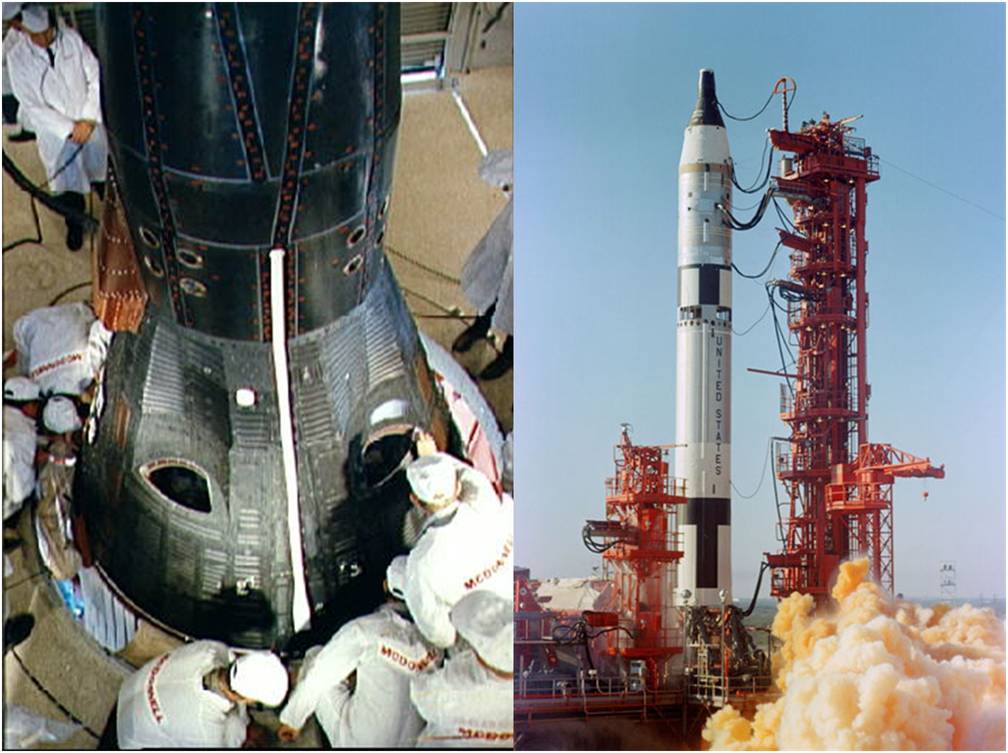
Forty-five years ago this week, Gemini III was launched into Earth orbit with astronauts Vigil I. Grissom and John W. Young onboard. The 3-orbit mission marked the first time that the United States flew a multi-man spacecraft.
Project Mercury was America’s first manned spaceflight series. Project Apollo would ultimately land men on the Moon and return them safely to the Earth. In between these historic spaceflight efforts would be Project Gemini.
The purpose of Project Gemini was to develop and flight-prove a myriad of technologies required to get to the Moon. Those technologies included spacecraft power systems, rendezvous and docking, orbital maneuvering, long duration spaceflight and extravehicular activity.
The Gemini spacecraft weighed 8,500 pounds at lift-off and measured 18.6 feet in length. Gemini consisted of a reentry module (RM), an adapter module (AM) and an equipment module (EM).
The crew occupied the RM which also contained navigation, communication, telemetry, electrical and reentry reaction control systems. The AM contained maneuver thrusters and the deboost rocket system. The EM included the spacecraft orbit attitude control thrusters and the fuel cell system. Both the AM and EM were used in orbit only and discarded prior to entry.
Gemini-Titan III (GT-3) lifted-off at 14:24 UTC from LC-19 at Cape Canaveral, Florida on Tuesday, 23 March 1965. The two-stage Titan II launch vehicle placed Gemini 3 into a 121 nautical mile x 87 nautical mile elliptical orbit.
Gemini 3’s primary objective was to put the maneuverable Gemini spacecraft through its paces. While in orbit, Grissom and Young fired thrusters to change the shape of their orbital flight path, shift their orbital plane, and dip down to a lower altitude. Gemini 3 was also the first time that a manned spacecraft used aerodynamic lift to change its entry flight path.
As spacecraft commander, Gus Grissom named his cosmic chariot The Molly Brown in reference to a then-popular Broadway show; “The Unsinkable Molly Brown”. Grissom chose the moniker in memory of his first spaceflight experience wherein his Liberty Bell 7 Mercury spacecraft sunk in almost 17,000 feet of water during post-splashdown operations.
At almost two (2) hours into the mission, pilot John Young presented Grissom with his favorite sandwich which had been smuggled onboard. Grissom and Young took a bite of the corned beef sandwich and put it away since loose crumbs could get into spacecraft electronics with catastrophic results. Not amused, NASA management reprimanded the crew after the mission.
Gemini 3 splashed-down in the Atlantic Ocean at 19:16:31 UTC following a 3 orbit mission. The spacecraft landed 45 nautical miles short of the intended splashdown point due to a misprediction of aerodynamic lift. Although hot and sea-sick, Grissom refused to open the spacecraft hatches until the recovery ship USS Intrepid came on station.
Nine (9) additional Gemini space missions would follow the flight of Gemini 3. Indeed, the historical record shows that the Gemini Program would fly an average of every two (2) months by the time Gemini XII landed in December 1966. During that period, the United States would take the lead in the race to the Moon that it would never relinquish.
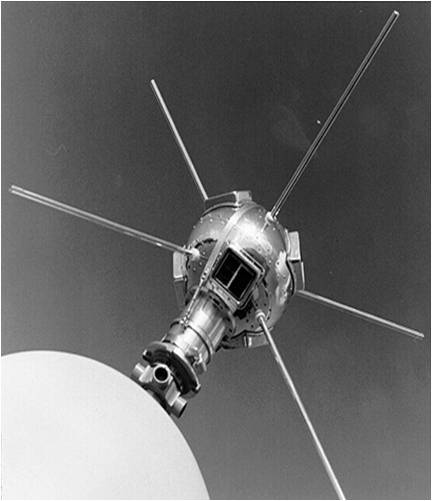
Fifty-two years ago this week, the United States Navy Vanguard Program registered its first success with the orbiting of the Vanguard 1 satellite. The diminutive orb was the fourth man-made object to be placed in Earth orbit.
The Vanguard Program was established in 1955 as part of the United States involvement in the upcoming International Geophysical Year (IGY). Spanning the period between 01 July 1957 and 31 December 1958, the IGY would serve to enhance the technical interchange between the east and west during the height of the Cold War.
The overriding goal of the Vanguard Program was to orbit the world’s first satellite sometime during the IGY. The satellite was to be tracked to verify that it achieved orbit and to quantify the associated orbital parameters. A scientific experiment was to be conducted using the orbiting asset as well.
Vanguard was managed by the Naval Research Laboratory (NRL) and funded by the National Science Foundation (NSF). This gave the Vanguard Program a distinctly scientific (rather than military) look and feel. Something that the Eisenhower Administration definitely wanted to project given the level of Cold War tensions.
The key elements of Vanguard were the Vanguard launch vehicle and the Vanguard satellite. The Vanguard 3-stage launch vehicle, manufactured by the Martin Company, evolved from the Navy’s successful Viking sounding rocket. The Vanguard satellite was developed by the NRL.
On Friday, 04 October 1957, the Soviet Union orbited the world’s first satellite – Sputnik I. While the world was merely stunned, the United States was quite shocked by this achievement. A hue and cry went out across the land. How could this have happened? Will the Soviets now unleash nuclear weapons on us from space? And most hauntingly – where is our satellite?
In the midst of scrambling to deal with the Soviet’s space achievement, America would receive another blow to the national solar plexus on Sunday, 03 November 1957. That is the day that the Soviet Union orbited their second satellite – Sputnik II. And this one even had an occupant onboard; a mongrel dog name Laika.
The Vanguard Program was uncomfortably in the spotlight now. But it really wasn’t ready at that moment to be America’s response to the Soviets. After all, Vanguard was just a research program. While the launch vehicle was developing well enough, it certainly was not ready for prime time. The Vanguard satellite was a new creation and had never been used in space.
History records that the first American satellite launch attempt on Friday, 06 December 1957 went very badly. The launch vehicle lost thrust at the dizzying height of 4 feet above the pad, exploded when it settled back to Earth and then consumed itself in the resulting inferno. Amazingly, the Vanguard satellite survived and was found intact at the edge of the launch pad.
Faced with a quickly deteriorating situation, America desperately turned to the United States Army for help. Wernher von Braun and his team at the Army Ballistic Missile Agency (ABMA) responded by orbiting Explorer I on Friday, 31 January 1958. America was now in space!
The Vanguard Program regrouped and attempted to orbit a Vanguard satellite on Wednesday, 05 February 1958. Fifty-seven seconds into flight the launch vehicle exploded. Vanguard was now 0 for 2 in the satellite launching game. Undeterred, another attempt was scheduled for March.
Monday, 17 March 1958 was a good day for the Vanguard Program and the United States of America. At 12:51 UTC, Vanguard launch vehicle TV-4 departed LC-18A at Cape Canaveral, Florida and placed the Vanguard I satellite into a 2,466-mile x 406-mile elliptical orbit. On this Saint Patrick’s Day, Vanguard registered its first success and America had a second satellite orbiting the Earth.
Whereas the Soviet satellites weighed hundreds of pounds, Vanguard I was tiny. It was 6.4-inches in diameter and weighed only 3.25 pounds. Soviet Premier Nikita Khrushchev mockingly referred to it as America’s “grapefruit satellite”. Small maybe, but mighty as well. Vanguard I went on to record many discoveries that helped write the book on spaceflight.
Khrushchev is gone and all of those big Sputniks were long ago incinerated in the fire of reentry. Interestingly, the “grapefruit satellite” is still in space and is the oldest satellite in Earth orbit. Vanguard I has completed roughly 200,000 Earth orbits and traveled 5.7 billion nautical miles since 1957. It is expected to stay in orbit for another 200 years. Not bad for a grapefruit.
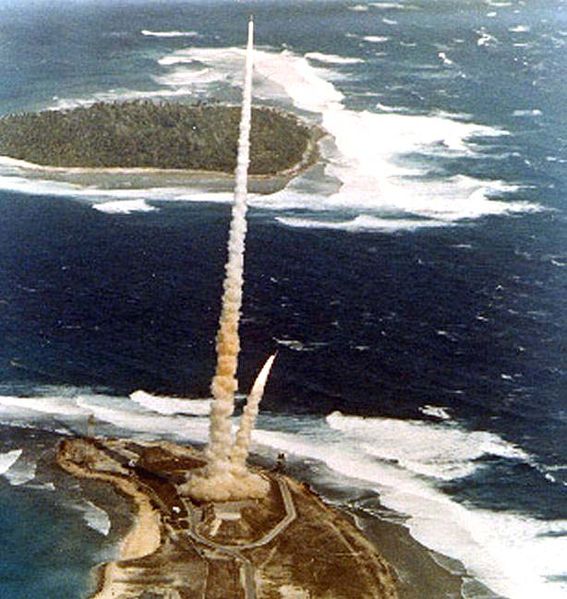
Thirty-nine years ago this month, a pair of SPRINT ABM interceptors fired from the Kwajalein Missile Range intercepted a reentry vehicle launched from Vandenberg Air Force Base, California. It was the first salvo launch of the legendary hypersonic interceptor.
The Safeguard Anti-Ballistic Missile (ABM) System was developed between the mid-960’s and mid-1970’s to protect United States ICBM sites. Safeguard consisted of an exoatmospheric missile (Spartan) and an endoatmospheric interceptor (SPRINT). In today’s missile defense paralance, we would refer to these vehicles as mid-course and terminal phase interceptors, respectively.
The 3-stage Spartan measured 55 feet in length, weighed 28,700 pounds at launch and had a range of 465 miles. Vehicle maximum velocity was in excess of 4,000 ft/sec. Spartan was armed with a 5-megaton nuclear warhead. Target destruction was effected via neutron flux.
The Solid Propellant Rocket INTerceptor (SPRINT) missile was a 2-stage vehicle. It measured 27 feet in length, weighed 7,500 pounds at launch and had a maximum range of 25 miles. SPRINT was configured with a nuclear warhead that had a yield on the order of several kilotons. Target destruction was also via radiation kill.
SPRINT’s performance was astounding by any measure. One second after first stage rocket motor ignition, the vehicle was already a mile away from the launch site. The Mach 5 stage separation event occurred a little over 1.2 seconds from first stage ignition.
The SPRINT upper stage saw a peak acceleration of 100 g’s and reached Mach 10 in about 6 seconds. Maximum mission duration was 15 seconds.
SPRINT’s rapid velocity build-up produced a correspondingly rapid rise in the vehicle’s surface temperature due to aerodynamic heating. The second stage glowed incandescently in daylight as its surface temperature exceeded that of an acetylene torch. The severe thermal state also resulted in the shock layer flow near the missile’s surface becoming a partially-ionized plasma.
SPRINT electromechanical and electronic equipment had to be ruggedized to handle the extreme shock, vibration, and acceleration environment of flight. In addition, the vehicle was hardened to withstand the severe pressure and electromagnetic pulses associated with a thermonuclear warhead detonation.
SPRINT flight testing started at White Sands Missile Range (WSMR) in November of 1965. Devoted to SPRINT subsystem testing, the WSMR flight test campaign ended in August 1970 and consisted of 42 shots.
Overall Safeguard system testing was conducted at the Kwajalein Missile Range (KMR) beginning in 1970 and extended through 1973. The KMR flight test program consisted of 34 flight tests. The first successful SPRINT intercept of a reentry vehicle took place in December 1970.
On Wednesday, 17 March 1971, SPRINT interceptors FLA-49 and FLA-50 were launched in salvo from Meck Island located on the eastern edge of the Kwajalein Atoll. The target for this mission was a Minuteman I reentry vehicle launched 4,800 miles to the east at Vandenberg Air Force Base. The target was successfully engaged and destroyed.
In October of 1974, a single Safeguard System unit became operational at Grand Forks Air Force Base, North Dakota. Interestingly, by February 1976, this lone deployed unit would be permanently deactivated. Thus ended the Safeguard ABM Program. A combination of high costs, questionable efficacy, lack of congressional support and international politics accounted for its very brief operational life.
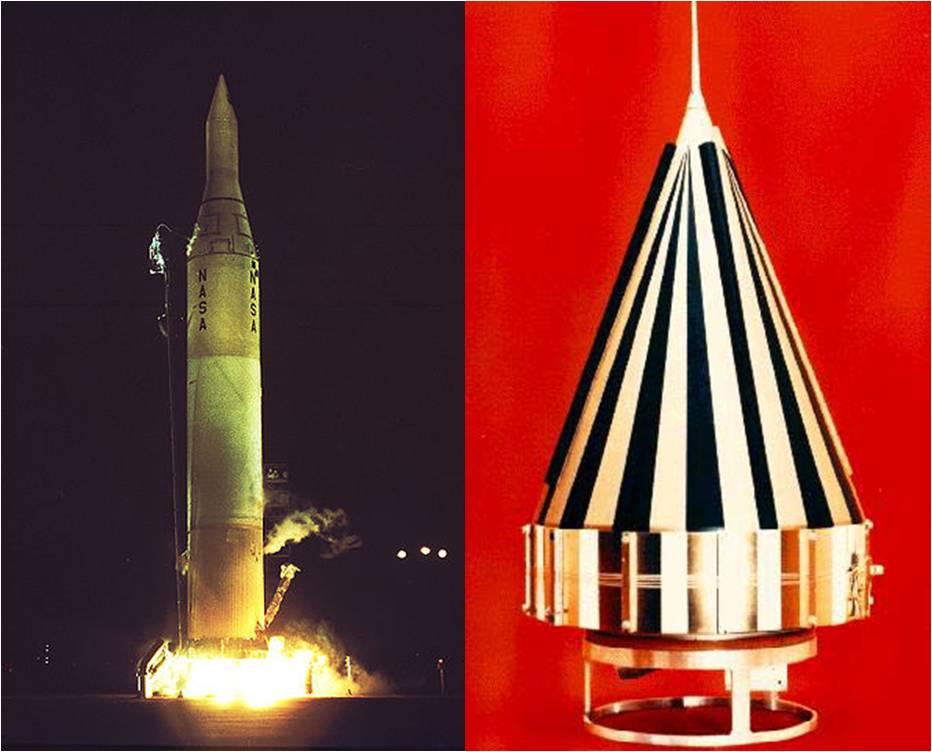
Fifty-one years ago this week, NASA’s Pioneer 4 probe flew within 37,000 miles of the lunar surface. In doing so, the spacecraft flew the first successful American lunar flyby mission.
The Pioneer Program was a series of planetary space missions conducted by NASA between 1958 and 1978. The target of the early missions (1958-1960) was the Moon. The one exception was Pioneer 5 which investigated the interplanetary medium between Earth and Venus. Later Pioneer mission (1965-1978) were devoted to investigation of Jupiter and Saturn.
It was tough sledding in the early days of the Pioneer Program where the primary goal was to orbit the Moon. However, launch vehicle reliability was simply too poor and space trajectory control too crude to meet the lunar orbit goal in the lat 1950’s.
Indeed, none of the ten (10) Pioneer missions flown in the 1958-1960 period managed to achieve a lunar orbit of any kind. Interestingly, the United States would not orbit a spacecraft around the Moon until the Lunar Orbiter 1 mission in August of 1966.
While the lunar orbit goal proved too daunting for the early Pioneer Program, a lunar flyby mission was feasible using extant technology. The flyby mission simply required the spacecraft to sweep by the Moon (without impacting the surface) as the probe moved along an interplanetary trajectory towards the Sun. Ultimately, the spacecraft would find itself in solar orbit.
The Pioneer 4 spacecraft was a cone 20-inches in length and 9-inches in diameter. It weighed a mere 13.5 pounds. Spin-stabilization was effected by spinning the vehicle at 400 rpm about its longitudinal axis. Instrumentation was sparse; just a photoelectric sensor and a pair of radiation sensors.
On Tuesday, 03 March 1959, a Juno II launch vehicle carrying the Pioneer 4 spacecraft lifted-off from Cape Canaveral, Florida at 1711 UTC. The 4-stage Juno II was a modification of the Juno I launch vehicle that orbited America’s first satellite (Explorer 1) on Friday, 31 January 1958.
Pioneer 4 was successfully placed into an interplanetary trajectory that saw the probe pass within 37,000 miles of the lunar surface at 22:25 UTC on Wednesday, 04 March 1959. Considering that the Moon is about 238,000 miles from Earth, the flyby wasn’t all that close. However, at the dawn of the space age, it was indeed a significant accomplishment.
Pioneer 4 was powered by mercury batteries; that is, the spacecraft did not use solar cells. Sensor measurements were telemetered back to Earth at 960.05 MHz via a 0.1-Watt transmitter. Earth-based stations tracked the space probe out to a distance of roughly 407,000 miles from Earth.
At 01:00 UTC on Wednesday, 18 March 1959, Pioneer 4 reached the closest point in its eternal orbit about the Sun. Having done so, Pioneer 4 would forever hold the distinction of being the first American spacecraft to transit interplanetary space and reach heliocentric orbit.
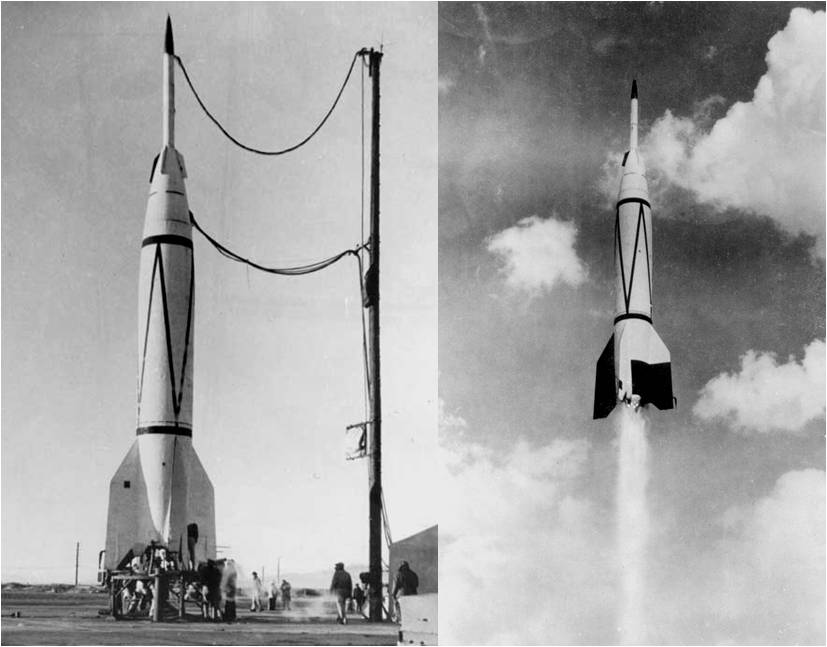
Sixty-one years ago this week, a United States two-stage liquid-fueled rocket reached a then-record altitude of 250 miles. Launch took place from Pad 33 at White Sands Proving Ground (WSPG), New Mexico.
The Bumper Program was a United States Army effort to reach flight altitudes and velocities never before achieved by a rocket vehicle. The name “Bumper” was derived from the fact that the lower stage would act to “bump” the upper stage to higher altitude and velocity than it (i.e., the upper stage) was able to achieve on its own.
The Bumper Program, which was actually part of the Army’s Project Hermes, officially began on Friday, 20 June 1947. The project team consisted of the General Electric Company, Douglas Aircraft Company and Cal Tech’s Jet Propulsion Laboratory. A total of eight (8) test flights took place between May 1948 and July 1950.
The Bumper two-stage configuration consisted of a V-2 booster and a WAC Corporal upper stage. The V-2’s had been captured from Germany following World War II while the WAC Corporal was a single stage American sounding rocket. The launch stack measured 62 feet in length and weighed around 28,000 pounds.
Propulsion-wise, the V-2 booster generated 60,000 pounds of thrust with a burn time of 70 seconds. The WAC Corporal rocket motor produced 1,500 pounds of thrust and had a burn time of 47 seconds.
The flight of Bumper-WAC No. 1 occurred on Thursday, 13 May 1948. This was an engineering test flight in which the WAC Corporal achieved a peak altitude of 79 miles. Unfortunately, the next three (3) flights were plagued by development problems of one kind or another and failed to achieve an altitude of even 10 miles.
Bumper-WAC No. 5 was fired from WSPG on Thursday, 24 February 1949. The V-2 burned-out at an altitude of 63 miles and a velocity of 3,850 feet per second. The WAC Corporal accelerated to a maximum velocity of 7,550 feet per second and then coasted to an apogee of 250 miles.
With generation of a very thin bow shock layer and high aerodynamic surface heating levels, the flight of Bumper-WAC No. 5 can be considered as the first time a man-made flight vehicle entered the realm of hypersonic flight. Notwithstanding that achievement, its maximum Mach number of 7.6 would be eclipsed in July of 1950 when Bumper-WAC No. 7 reached Mach 9.
Three (3) more Bumper-WAC missions would follow Bumper-WAC No.5. While Bumper-WAC No. 6 would fly from WSPG, the final two (2) missions were conducted from an isolated Florida launch site in July of 1950.
The hot, bug-infested Floridian launch location, springing-up amongst sand dunes and scrub palmetto, would one day become the seat of American spaceflight. It was known then as the Joint Long-Range Proving Ground. Today, we know it as Cape Canaveral.
The Bumper Program successfully demonstrated the efficacy of the multi-staging concept. Bumper also provided valuable flight experience in stage separation and high altitude rocket motor ignition systems. In short, Bumper played a vital role in helping America successfully develop its ICBM, satellite and manned spaceflight capabilities.
While its historical significance, and even its existence, has been lost to many here in the 21st Century, the Bumper Program played a major role in our quest for the Moon. As such, it will forever hold a hollowed place in the annals of United States aerospace history.
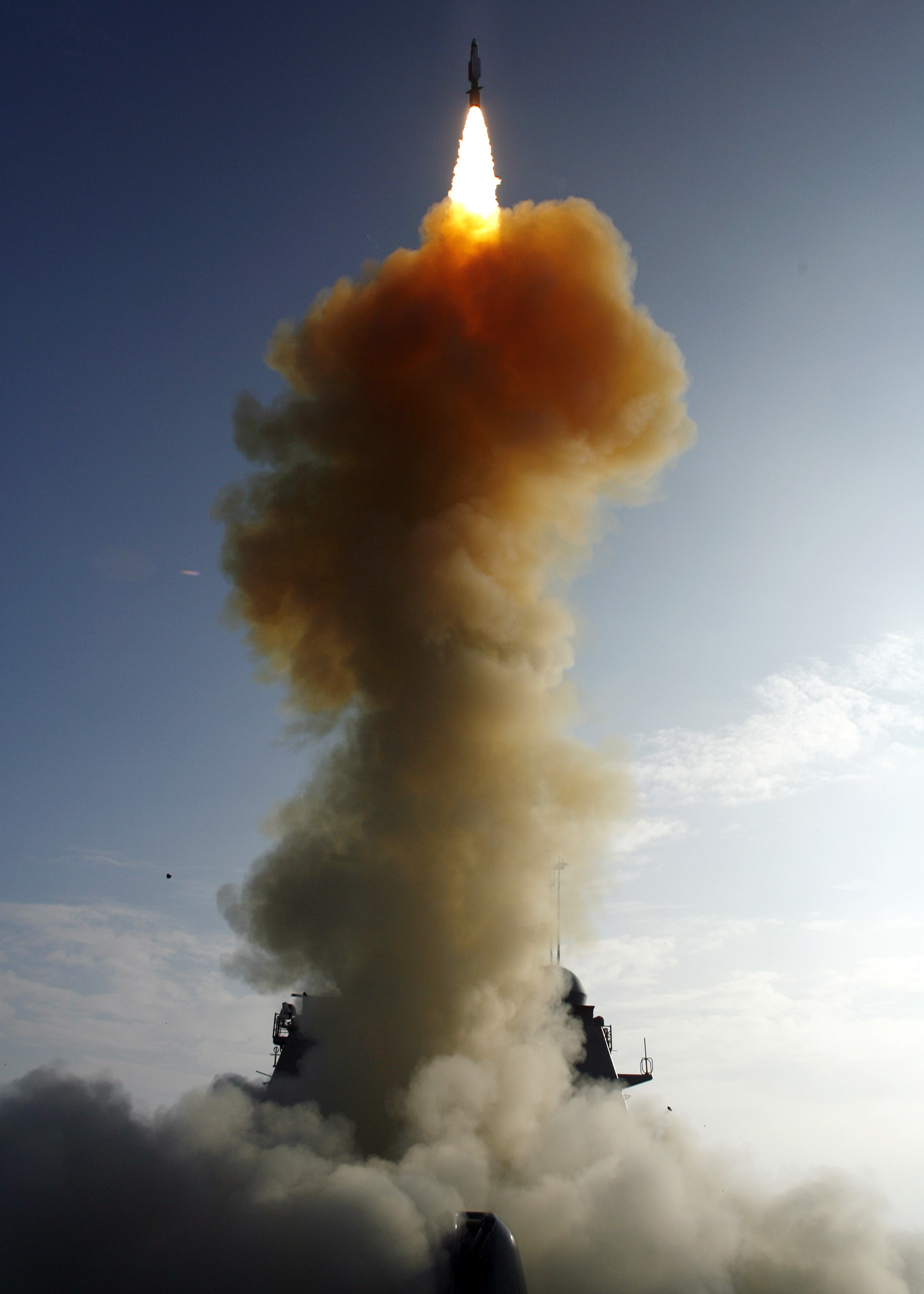
Two years ago this month, a United States Navy STANDARD Missile SM-3 Block IA intercepted and destroyed a failed NRO satellite at an altitude of 133 nautical miles. The relative velocity at intercept was in excess of 22,000 mph.
The United States Navy/Raytheon Missile Systems SM-3 (RIM-161) is the sea-based arm of the Missile Defense Agency’s Ballistic Missile Defense System (BMDS). The 3-stage missile carries a Kinetic Warhead (KW) that provides an exoatmospheric hit-to-kill capability.
In order to ensure a lethal hit, the SM-3 KW guides to a specific aimpoint on the target’s airframe. The ability to reliably do so has been impressively demonstrated in a series of intercept flight tests that began in 2002.
SM-3 rounds are launched from the MK-41 Vertical Launcher System (VLS) aboard United States Navy cruisers and destroyers. The at-sea basing concept provides for a high degree of operational flexibility in the ballistic missile intercept mission.
The Lockheed Martin-built USA-193 was launched on a classified mission from California’s Vandenberg Air Force Base (VAFB) at 2100 UTC on Thursday, 14 December 2006. Shortly after reaching orbit, contact with the 5,000-lb satellite was lost.
By January 2008, USA-193’s orbit had decayed to such an extent that its reentry appeared imminent. Such events raise concerns for the safety of those on Earth who reside within the debris impact footprint. However, there was an additional concern in the case of USA-193. The satellite still had about 1,000-lbs of hydrazine onboard.
Should the USA-193 hydrazine tank survive reentry, those living in the impact area would be exposed to a highly toxic cloud of the volatile substance. Officials concluded that the safest thing to do was to destroy the satellite before it reentered the atmosphere.
On Thursday, 21 February 2008, the USS Lake Erie was on station in the Pacific Ocean west of Hawaii. The US Navy cruiser fired a single SM-3 interceptor at 0326 UTC. Minutes later, the missile’s KW took out the satellite and dispersed its hydrazine load into space. Mission accomplished!
In the aftermath of the satellite take-down, Russia and others predictably accused the United States of using the USA-193 hydrazine issue as an excuse to demonstrate SM-3’s anti-satellite capability. While such capability was indeed demonstrated, noteworthy is the fact that all systems modified to execute the satellite intercept have subsequently been returned to a ballistic missile defense posture.
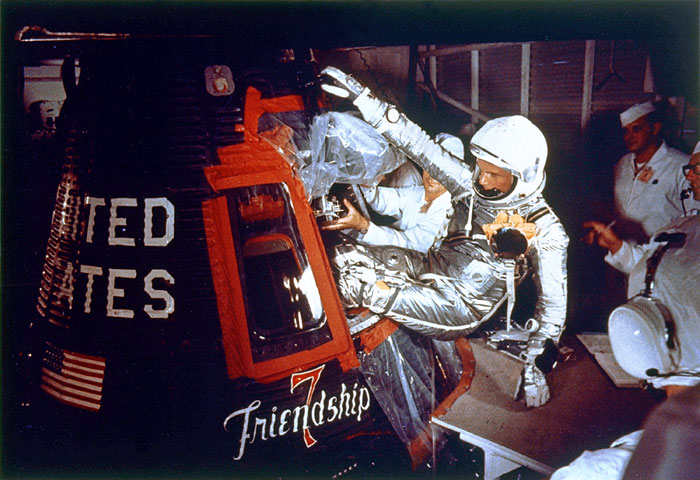
Forty-eight years ago this month, Project Mercury Astronaut John H. Glenn, Jr. became the first American to orbit the Earth. Glenn’s spacecraft name and mission call sign was Friendship 7.
Mercury-Atlas 6 (MA-6) lifted-off from Cape Canaveral’s Launch Complex 14 at 14:47:39 UTC on Tuesday, 20 February 1962. It was the first time that the Atlas LV-3B booster was used for a manned spaceflight.
Three-hundred and twenty seconds after lift-off, Friendship 7 achieved an elliptical orbit measuring 143 nm (apogee) by 86 nm (perigee). Orbital inclination and period were 32.5 degrees and 88.5 minutes, respectively.
The most compelling moments in the United States’ first manned orbital mission centered around a sensor indication that Glenn’s heatshield and landing bag had become loose at the beginning of his second orbit. If true, Glenn would be incinerated during entry.
Concern for Glenn’s welfare persisted for the remainder of the flight and a decision was made to retain his retro package following completion of the retro-fire sequence. It was hoped that the 3 straps holding the retro package would also hold the heatshield in place.
During Glenn’s return to the atmosphere, both the spent retro package and its restraining straps melted in the searing heat of re-entry. Glenn saw chunks of flaming debris passing by his spacecraft window. At one point he radioed, “That’s a real fireball outside”.
Happily, the spacecraft’s heatshield held during entry and the landing bag deployed nominally. There had never really been a problem. The sensor indication was found to be false.
Friendship 7 splashed-down in the Atlantic Ocean at a point 432 nm east of Cape Canaveral at 19:43:02 UTC. John Glenn had orbited the Earth 3 times during a mission which lasted 4 hours, 55 minutes and 23 seconds. Within short order, spacecraft and astronaut were successfully recovered aboard the USS Noa.
John Glenn became a national hero in the aftermath of his 3-orbit mission aboard Friendship 7. It seemed that just about every newspaper page in the days following his flight carried some sort of story about his historic fete. Indeed, it is difficult for those not around back in 1962 to fully comprehend the immensity of Glenn’s flight in terms of what it meant to the United States.
John Herschel Glenn, Jr. will turn 89 on 18 July 2010. His trusty Friendship 7 spacecraft is currently on display at the Smithsonian National Air and Space Museum in Washington, DC.











